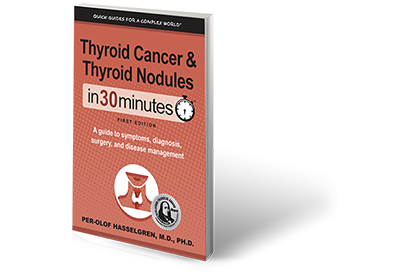Most thyroid nodules are benign but they may also contain cancer. The incidence of thyroid cancer in the population has trended upwards during the last several decades. The good news is that most thyroid cancers are treatable and associated with an excellent prognosis. The most common forms of thyroid cancer are
- Papillary thyroid cancer (70-80%)
- Follicular thyroid cancer (10-20%)
- Medullary thyroid cancer (3-5%)
- Anaplastic thyroid cancer (1-2%)
Classification of cytology and staging of thyroid cancer
The classification of cytology is based on the microscopic appearance of the cells obtained during a FNA. The so-called Bethesda system includes six classes (Bethesda I to Bethesda VI). The Bethesda classification is used to assess the risk of malignancy in a thyroid nodule with higher Bethesda classifications being more suspicious for cancer.
The staging of a thyroid cancer is used to help decide best treatment and estimate the prognosis. The most commonly used staging is the TNM system based on the size of the tumor (T), the absence or presence of lymph node metastases (N) and distant metastases (M). Thyroid cancers are staged from I to IV, with the higher stages representing more advanced cancers requiring more aggressive treatment.
Importantly, the cancer staging requires that tissue is examined (as opposed to the Bethesda classification that is based on examination of cells). Staging of the cancer therefore is typically not performed until after surgery has been performed.
For more information on these topics, see Chapter 3: Doctors, tests, and classifications and Chapter 5: Thyroid Cancer in Thyroid Cancer and Thyroid Nodules In 30 Minutes.
